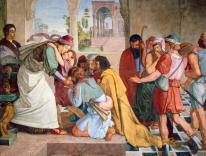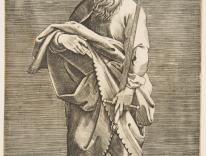All Christology begins "from below." Rahner’s distinction, "from below/from above," describes the plots of the Christological stories we tell, but not the genesis or sources of those stories. Too often we fail to make that distinction.
Christology begins in disciples’ imaginative responses to the "Caesarea Philippi" question. That’s what Mark portrays the disciples and Peter doing. They answer Jesus imaginatively with code words ("Elijah," "John the Baptist," "Messiah") that are shorthand for stories about "who he is."
New Testament Christological narratives have two types of plots. The ascending types (for example, in the synoptics) tell stories of how "God made a man God’s Son." The descending forms (for example, in the Christological hymns) tell stories of how "God made the Son a man." Of course, the New Testament makes many other Christological claims. But these two plots pattern the Christological imagination.
Subsequent controversies are debates over which story should dominate. Christological heresies result when one story cancels the other. It is easy for ascending Christologists to fall into patterns that shortchange the true divinity of Christ, and for descending Christologists to slip into patterns that practically deny Christ’s humanity.
Christian disciples continue these exercises to the present, as Robert Krieg reminds us. We continue to tell stories to account for the scandalous particularity of the divine reality present fully in this one person. We start from where we are: here below. We can’t descend from heaven, but we can recall the responses of our forebears and our colleagues.
The problem is not where Christologists start. The real issue is working out the plots of our stories. We need both plot lines. Can we truly tell only ascending stories that manifest well the divine reality? Can we truly tell only descending stories that faithfully capture the human reality? I don’t know. My hunch is that we will need "two narratives" for our Christologies, just as the Council of Chalcedon (a.d. 451) needed the "two natures" formula.
Recently, answering another set of questions has become de rigueur for Christology: "What is the status of other religious traditions and their members regarding Jesus, God, salvation, and the church?"
I am convinced these types of questions are as problematical as "Why does God allow evil in the world?" I have argued that constructing theodicies to answer questions about "God and evil" perpetuates old evils and creates new evils (see my The Evils of Theodicy [Georgetown]). Analogously, providing theories to answer "Christianity and the religions" questions is also unsatisfactory. Trying to answer "When and how will God save those who know not Christ?" may be like trying to answer "When and how will you start loving your spouse?" Arguing for this claim, though, is work for another day.
I did find unexpected support from Avery Dulles for not trying to provide a theological answer to the question of how Christianity and the other religious traditions are related. In "Christ among the Religions" (America, February 2), Dulles in effect backs off from theoretical answers to these questions. He advocates what amounts to a turn to the practices of tolerance, peaceful coexistence, and joint projects. Avoiding theory and turning to practices may well be the best "answer" to such questions. Even if we cannot say how God works, we can show our faith in God’s work.
We don’t need to develop a theory to show how God works it out. We do need to get our Christological stories straight when we respond to, "Who do you say that I am?" We do need to show that we can talk without contradiction of God’s universal salvific will and the scandalous particularity of the incarnate and risen Lord. These challenges make Christology interesting-and necessary, now as ever.
Please email comments to [email protected] and join the conversation on our Facebook page.
Share
Previous Story
Easier Said Than Defined
Next Story
Smile When You Say 'Laity'

